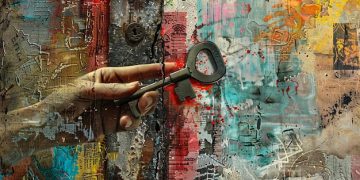Graffiti Art as Investment: Should You Buy Emerging US Artists?

Navigating the burgeoning market of street art as an asset class reveals that while the cultural significance and historical impact of graffiti are undeniable, investing in pieces from emerging US artists requires careful consideration of market volatility, provenance, and the evolving nature of the art world’s acceptance of graffiti art.
In the dynamic landscape of art acquisition, a seismic shift has been brewing, pushing boundaries and challenging traditional perceptions of value. For many, the question looms large: Graffiti Art as Investment: Is Now the Time to Buy Pieces from Emerging US Artists? This inquiry delves into a fascinating confluence of urban culture, artistic innovation, and market potential, inviting a closer look.
The Evolving Perception of Graffiti Art in the Mainstream
Graffiti art, once relegated to the fringes of urban society and often associated with vandalism, has undergone a profound transformation in its public and critical perception. This journey from illicit act to acclaimed art form is complex, reflecting broader shifts in cultural discourse and the art market’s constant search for novelty and authenticity.
Historically, graffiti’s ephemeral nature and its medium—public walls—made it difficult to categorize within conventional art frameworks. However, the sheer talent, communicative power, and raw energy displayed by its practitioners have steadily eroded these barriers. Major galleries and auction houses, once exclusive domains for “high art,” now regularly feature works by artists whose roots are firmly planted in street art.
From Streets to Galleries: A Cultural Shift
The transition from public spaces to private collections and esteemed institutions marks a significant turning point. This recontextualization has been instrumental in legitimizing graffiti art, allowing a wider audience to appreciate its technical prowess and thematic depth. It’s a testament to individual artists who maintained their unique visions while adapting to new platforms.
- Early exhibitions of graffiti artists in New York in the 1970s and 80s were pivotal.
- Documentaries and books played a crucial role in demystifying the culture.
- The rise of social media has amplified global exposure for street artists.
This evolving perception is not merely about acceptance; it’s about recognition of a distinct artistic lineage that speaks to contemporary urban experiences. It challenges established norms of what art can be, where it can originate, and who can create it. This cultural maturation forms the bedrock upon which its investment potential is now being built, inviting serious consideration from collectors and investors alike.
The journey from public walls to prestigious exhibition spaces highlights a profound shift in artistic appreciation. This evolution is vital for understanding the increasing value attributed to graffiti art and its artists. It underscores how what was once dismissed is now celebrated, opening new avenues for art investment.
Understanding the Market for Emerging US Graffiti Artists
For those considering graffiti art as an investment, especially from emerging US artists, comprehending the market dynamics is paramount. Unlike established art markets with decades of sales data and a clear hierarchy, the market for emerging artists, particularly in a relatively young genre like graffiti, is characterized by its fluidity, rapid growth, and unique risk factors.
Emerging artists often present a higher risk-reward profile. Their work may be more accessible in terms of price but lacks the proven track record of blue-chip artists. However, the potential for exponential growth can be immense if an artist gains significant recognition. This requires a discerning eye and a deep understanding of what drives value in this particular niche.
Key Factors Influencing Value and Growth
Several elements contribute to an emerging artist’s market trajectory. Beyond raw talent, factors such as critical acclaim, gallery representation, social media presence, and even their backstory can significantly impact demand and price. Investors need to look beyond superficial appeal to assess genuine artistic merit and commercial viability.
- Authenticity and Originality: Does the artist have a unique voice or technique that sets them apart?
- Critical Engagement: Are their works being reviewed by art critics or featured in reputable publications?
- Gallery Representation: Association with respected galleries can lend credibility and market access.
- Social Media Reach: A strong online presence can indicate growing public interest and direct engagement.
The market for graffiti art is also influenced by its cultural origins. Many collectors are drawn to the art form’s rebellious spirit and connection to urban youth culture. This emotional connection can translate into passionate collecting, sometimes driving prices beyond traditional valuations based purely on aesthetic or technical skill. Navigating this market requires both an analytical mind and an appreciation for the cultural context.
Investing in emerging graffiti artists involves a mix of art appreciation and market foresight. The growth trajectory of these artists is dynamic, influenced by a blend of artistic innovation and effective market strategies. Understanding these drivers is key to making informed investment decisions in this exciting field.
Identifying Promising Emerging US Artists: What to Look For
Identifying the next wave of influential artists within the vibrant landscape of US graffiti art requires more than just a casual glance. It demands an informed approach, blending keen observation with an understanding of both artistic merit and market indicators. While no investment is guaranteed, certain characteristics often signal an artist’s potential for sustained growth and recognition.
Firstly, seek out artists who demonstrate a unique artistic voice. In a field as diverse as graffiti, originality is paramount. This isn’t just about technical skill, but about how an artist translates their vision, experiences, and cultural commentary into their work. Are they pushing boundaries, redefining techniques, or offering fresh perspectives on established motifs?
Artistic Merit and Market Indicators
Beyond originality, consistency in quality across their body of work is a strong indicator. An artist who consistently produces compelling pieces, even as their style evolves, demonstrates dedication and a mature artistic process. This consistency builds confidence among collectors and validates their trajectory.
- Unique Style: Look for artists with a distinctive aesthetic that stands out.
- Technical Prowess: Assess their mastery of tools and techniques within their chosen medium.
- Narrative Depth: Does their art tell a story, evoke emotion, or provoke thought?
- Exhibition History: Even for emerging artists, participation in group shows or independent exhibitions shows engagement.
Furthermore, observe their engagement within the broader art community and their digital footprint. While traditional gallery representation remains important, many emerging graffiti artists leverage social media and online platforms to build their brand and connect directly with audiences. A significant, authentic following and positive interaction can be a powerful market signal, indicating growing interest and a loyal fan base.
Finally, consider the artist’s commitment to their craft and their long-term vision. An artist who views their work as a sustained practice, rather than a fleeting trend, is more likely to develop a lasting legacy. Researching their background, influences, and statements about their art can offer valuable insights into their dedication and future potential. This holistic approach helps in discerning true artistic talent from transient popularity.
Pinpointing artists with long-term potential goes beyond surface appeal. It requires a deep dive into their artistic integrity, stylistic distinctiveness, and dedication to their craft, ensuring a more promising investment in the evolving art market.

Provenance, Authenticity, and Valuation Challenges
In the art market, especially for genres that originated outside traditional gallery systems, issues of provenance, authenticity, and valuation pose unique challenges. This is particularly true for graffiti art, where the line between street pieces and collectible works can sometimes be blurred. For investors, understanding and mitigating these risks is crucial for safeguarding their acquisitions.
Provenance, the documented history of an artwork’s ownership, is a cornerstone of value and authenticity in the art world. For graffiti art, documentation can be more complex. Unlike a painting sold directly from a studio or gallery with immediate records, many early graffiti pieces were created in public, leading to less formal records of their origin and subsequent ownership. While this adds to the genre’s mystique, it also necessitates more diligent research for collectors.
Ensuring Authenticity in a Niche Market
Authenticity is another significant hurdle. The raw, often anonymous nature of street art can make it challenging to verify. This is where professional authentication services and reputable dealers become indispensable. An emerging artist gaining recognition will often begin to formalize their practice, offering certificates of authenticity and engaging in practices that help establish a clear provenance for their studio works.
- Certificates of Authenticity: Always request this directly from the artist or an authorized representative.
- Reputable Dealers: Purchase from galleries or dealers with a strong track record and specialized knowledge in graffiti art.
- Artist Signatures: While not foolproof, a consistent signature style is a basic verification step.
- Exhibition Records: Documented exhibition history for a piece can confirm its existence and ownership.
Valuation in the graffiti art market is equally nuanced. Factors like the artist’s notoriety, the medium used (canvas, print, object), the period of creation, and even the subject matter can influence price. For emerging artists, valuation is often more speculative, relying on future potential rather than historical sales. Staying informed about burgeoning artists through art publications, online platforms, and expert opinions becomes vital. This meticulous approach to vetting an artwork and its history is essential for confident investment.
Navigating the complexities of provenance and authenticity in graffiti art requires careful attention and due diligence from collectors. Establishing clear documentation and trusting reputable sources are critical steps to ensure the long-term value and legitimacy of investments. The market’s unique characteristics demand informed and cautious engagement.
Risks and Rewards: A Balanced Perspective for Investors
Investing in graffiti art, especially pieces from emerging US artists, presents a unique blend of risks and potential rewards. While the allure of discovering the next art sensation is strong, a balanced perspective requires a clear-eyed understanding of the challenges involved. This market is not for the faint of heart, but for those willing to educate themselves, the returns can be significant.
The primary risk lies in the inherent speculative nature of emerging art. Many artists, despite initial promise, may not achieve sustained market recognition. Trends can shift rapidly, and an artist’s popularity might prove fleeting. Additionally, the liquidity of art as an asset class can be an issue; selling a piece can take time, and finding the right buyer at the desired price is not always guaranteed, particularly for less established artists.
Mitigating Risks and Maximizing Potential
However, the rewards can be substantial. Successful early investment in a rising artist can lead to significant appreciation in value, far outstripping returns often seen in more traditional investments. Beyond financial gain, there’s the intrinsic reward of supporting contemporary art and being part of an evolving cultural movement. The unique narrative and vibrancy of graffiti art can also offer a profound personal connection to the artwork.
- Diversify Your Portfolio: Don’t put all your investment capital into a single artist or genre.
- Due Diligence: Thoroughly research the artist, their market, and the specific artwork’s provenance.
- Long-Term View: Art investment often requires patience; significant returns typically accrue over years.
- Connect with Experts: Seek advice from art consultants, gallerists, and experienced collectors in the field.
Moreover, the cultural significance of graffiti art offers a non-financial return. This art form often functions as a powerful social commentary, reflecting urban experiences and challenging societal norms. Owning such a piece can be a statement in itself, connecting the collector to a vital contemporary dialogue. For the investor who values both cultural impact and financial potential, emerging graffiti art offers a compelling proposition, provided they navigate its intricacies with care and knowledge.
Investing in emerging graffiti art demands a strategic approach balancing enthusiasm with caution. While risks are inherent, through careful research and diversification, collectors can enhance their likelihood of both financial and cultural returns. It is a long-term commitment that rewards patience and an informed perspective.
The Impact of Digitalization and NFTs on Graffiti Art Investment
The advent of digitalization and Non-Fungible Tokens (NFTs) has profoundly reshaped various sectors, and the art market, particularly for graffiti art, is no exception. These technological advancements introduce new avenues for creation, collection, and investment, offering both unprecedented opportunities and unique challenges.
Digitalization has democratized access to art, allowing artists to reach global audiences without traditional intermediaries. For graffiti artists, who often operate outside conventional gallery systems, online platforms have been instrumental in showcasing their work. High-quality digital images and virtual exhibitions permit broader appreciation, potentially increasing an artist’s visibility and demand, even for their physical works.
NFTs: A New Frontier for Collecting and Authenticity
NFTs represent a more revolutionary shift. By creating a unique digital token on a blockchain, NFTs provide immutable proof of ownership for digital assets. For street art, this means an artist can tokenize a photograph or video of their ephemeral mural, creating a collectible item that captures the essence of a piece that might otherwise be painted over or decay. This opens up entirely new markets for works that were previously uncollectible in a tangible way.
- Enhanced Authenticity: Blockchain technology can provide verifiable ownership records for digital art.
- Global Accessibility: NFTs can be bought and sold worldwide, expanding the collector base.
- New Revenue Streams: Artists can earn royalties on secondary NFT sales.
- Preservation of Ephemeral Art: NFTs can immortalize transient street art pieces.
However, the NFT market is highly volatile and speculative, especially for new artists. The immense potential for fraud and pump-and-dump schemes also requires extreme caution. Investors must conduct rigorous due diligence, understanding the artist’s reputation, the platform’s security, and the long-term viability of the digital assets they acquire. While NFTs offer exciting possibilities for fractional ownership and new forms of patronage, they also present a complex landscape requiring advanced digital literacy beyond traditional art market knowledge.
The integration of digital platforms and NFTs is ushering in a new era for graffiti art. While offering unprecedented opportunities for artists and investors, these technological shifts also demand heightened scrutiny regarding authenticity, market stability, and the long-term value assessment. Navigating this evolving digital terrain requires both foresight and caution.

Legal and Ethical Considerations in Collecting Graffiti Art
The intersection of legality, ethics, and art can be complex, and nowhere is this more apparent than in the realm of graffiti art. Given its origins often outside legal boundaries, collectors and investors must navigate a unique set of considerations to ensure their acquisitions are both legitimate and ethically sound. Understanding these nuances is crucial for responsible collecting.
A primary legal concern revolves around the legality of the artwork’s original creation. If a piece of graffiti was executed on public or private property without permission, it is legally considered vandalism. While a studio piece by the same artist is entirely legal to purchase, works directly cut from walls (known as “buffs” or “cut-outs”) or pieces created illicitly carry a different legal status. Their provenance can be fraught with potential legal challenges regarding ownership and intellectual property rights.
Ethical Responsibility and Respect for the Art Form
Beyond legality, ethical considerations come into play. Is it ethical to profit from art that was originally intended to be a public, often fleeting, statement? Some argue that removing graffiti from its original context diminishes its purpose and can be seen as an appropriation of urban culture. Collectors keen on supporting the art form should prioritize works created with the artist’s consent, especially those intended for sale through established channels.
- Permission for Creation: Verify if the original street piece was commissioned or legally sanctioned before purchasing derived works.
- Artist Compensation: Ensure the artist is directly benefiting from the sale of their work, whether physical or digital.
- Preservation vs. Commodification: Balance the desire to collect with respecting the original intent of street art.
- Intellectual Property: Understand the artist’s rights regarding reproduction and display of their work.
Furthermore, collectors have an ethical responsibility to ensure they are contributing positively to the graffiti art ecosystem rather than exploiting it. This means supporting artists directly, buying from reputable sources that genuinely advocate for the artists’ rights, and being mindful of the cultural context from which the art emerges. Transparency in transactions and a commitment to preserving the integrity of the art form ultimately benefit both the collector and the artistic community, ensuring the long-term vitality of graffiti art as a legitimate and valuable cultural asset.
Collecting graffiti art requires navigating a unique landscape of legal and ethical considerations. Responsible acquisition means supporting artists who create within legal frameworks and are justly compensated, ensuring that the passion for art contributes positively to the community it originates from. This respectful approach upholds the integrity of the art form and its artists.
| Key Aspect | Brief Description |
|---|---|
| 🎨 Market Evolution | Graffiti art transitioned from vandalism to mainstream galleries, validating its artistic and investment appeal. |
| 🔍 Artist Selection | Look for unique style, consistent quality, gallery representation, and strong online presence. |
| 📜 Provenance & Auth. | Critical to verify authenticity and ownership history, often challenging but essential for value. |
| 💹 Risks & Rewards | High potential for appreciation balanced by market speculation and liquidity challenges. |
Frequently Asked Questions About Graffiti Art Investment
▼
Graffiti art offers unique investment potential, often with higher growth ceilings for emerging artists due to its burgeoning market. Unlike traditional art, it’s still establishing its long-term market trends, making it more speculative but potentially more rewarding for early, informed investors. Its cultural relevance and increasing acceptance enhance its appeal.
▼
Authenticating graffiti art requires due diligence. Always seek a certificate of authenticity directly from the artist or a reputable gallery. Check for consistent artist signatures, documented exhibition history, and purchase from established dealers specializing in street art to ensure provenance and reduce fraud risk. Expert appraisals can also aid verification.
▼
NFTs offer a new frontier for graffiti art investment, allowing collectors to own unique digital tokens of artworks, especially ephemeral street pieces. They provide verifiable ownership through blockchain, enhancing authenticity for digital art. NFTs also create new revenue streams for artists and expand the global collector base, despite market volatility.
▼
Yes, ethical considerations are crucial. Ensure the artwork was created legally and the artist benefits directly from sales. Be mindful of pieces removed from public spaces without consent, as these can raise legal and moral issues. Supporting artists who operate within legal frameworks fosters a healthier and more sustainable art market.
▼
Key risks include market speculation, as many emerging artists may not achieve sustained recognition, and liquidity issues, as reselling can be challenging. Other risks involve authenticity concerns due to the art form’s origins and potential for market manipulation. Thorough research and a long-term investment horizon are essential to mitigate these risks.
Conclusion
Considering Graffiti Art as Investment: Is Now the Time to Buy Pieces from Emerging US Artists? requires a multifaceted approach that weighs cultural significance against market realities. While the journey from street to gallery has solidified its artistic legitimacy, the investment landscape remains dynamic and nuanced. For discerning collectors, the present moment offers compelling opportunities. By embracing due diligence, understanding market specificities, and engaging ethically with artists, one can navigate this exciting terrain effectively. Ultimately, success lies not just in financial appreciation but also in contributing to the recognition and longevity of a profoundly impactful art form.





